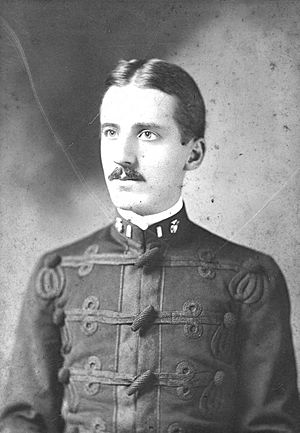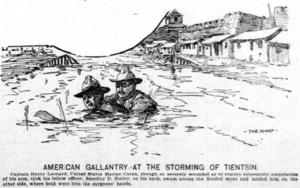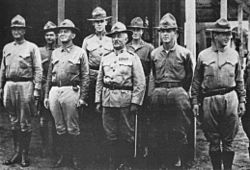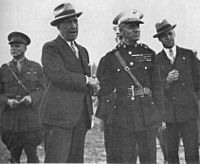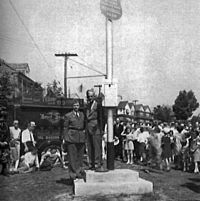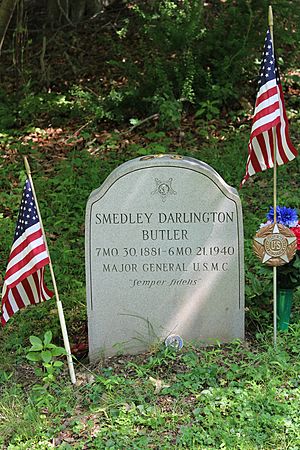Smedley Butler facts for kids
Quick facts for kids
Smedley Butler
|
|
|---|---|
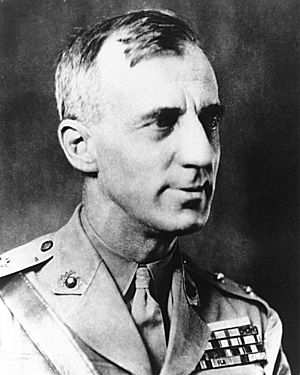
Butler in uniform, c. 1929
|
|
| Birth name | Smedley Darlington Butler |
| Nickname(s) | "Old Gimlet Eye" "The Fighting Quaker" "Fighting Hell-Devil" |
| Born | July 30, 1881 West Chester, Pennsylvania, U.S. |
| Died | June 21, 1940 (aged 58) Philadelphia, Pennsylvania, U.S. |
| Buried |
Oaklands Cemetery, West Goshen Township, Pennsylvania
(39°58′46.4″N 75°37′17.7″W / 39.979556°N 75.621583°W) |
| Allegiance | United States of America |
| Service/ |
|
| Years of service | 1898–1931 |
| Rank | |
| Commands held |
|
| Battles/wars | Spanish–American War
|
| Awards |
|
| Relations |
|
| Other work | Activist, official, lecturer, writer |
| Director of Public Safety for Philadelphia | |
| In office January 7, 1924 – December 23, 1925 |
|
Major General Smedley Darlington Butler (July 30, 1881 – June 21, 1940) was a famous United States Marine Corps officer. People called him the "Maverick Marine" because he often spoke his mind. He fought in many conflicts, including the Philippine–American War, the Boxer Rebellion, the Mexican Revolution, and World War I.
During his 34 years as a Marine, Butler took part in military actions in places like the Philippines, China, and Central America. He became the most decorated Marine in U.S. history at the time of his death. He earned 16 medals, with five for his bravery. He is one of only 19 people to receive the Medal of Honor twice for different actions.
After he retired, Butler became a strong critic of wars and their reasons. In 1935, he wrote a book called War Is a Racket. In this book, he argued that wars are often started for money and business interests. He also became a popular speaker, sharing his views with veterans, peace groups, and church groups.
In 1934, Butler claimed that a group of rich businessmen were planning a military takeover of the U.S. government. He said they wanted him to lead it. This event became known as the Business Plot. A special committee in Congress looked into his claims and confirmed that some of what Butler said was true.
Contents
- Early Life and Joining the Marines
- Military Career and Adventures
- Retirement and Activism
- Later Life and Legacy
- Published Works
- Images for kids
- See also
Early Life and Joining the Marines
Smedley Darlington Butler was born on July 30, 1881, in West Chester, Pennsylvania. He was the oldest of three sons. His parents, Thomas and Maud Butler, came from Quaker families. His family had lived in North America since the 1600s.
His father, Thomas S. Butler, was a lawyer and a judge. He later served in the U.S. House of Representatives for 31 years. He was in charge of the House Naval Affairs Committee, which controlled the Marine Corps' money and people. Smedley's success in the Marines happened while his father held this powerful position.
Smedley went to West Chester Friends Graded High School and then The Haverford School. He was good at sports, becoming captain of the baseball team and quarterback of the football team. When he was almost 17, he left school to join the Marine Corps. This was during the Spanish–American War.
Military Career and Adventures
Fighting in the Spanish–American War
In 1898, Smedley Butler lied about his age to join the Marines as a second lieutenant. He trained in Washington, D.C. In July 1898, he went to Guantánamo Bay, Cuba, just after it was captured. His unit soon returned to the U.S. He left the service in February 1899 but rejoined as a first lieutenant in April 1899.
Battles in the Philippines and China
The Marine Corps sent Butler to Manila, Philippines. In October 1899, he led 300 Marines to capture the town of Noveleta from Filipino troops. He briefly felt scared when his first sergeant was hurt, but he quickly took charge and led his Marines to victory.
After this, he was stationed in the Philippines. He became good friends with another Marine, Littleton Waller. Soon, Butler and Waller were sent to China to help stop the Boxer Rebellion.
In China, Butler fought in the Battle of Tientsin on July 13, 1900. During the battle, he saw another Marine officer fall. He bravely left his trench to rescue him and was shot in the thigh. Another Marine helped him to safety, but that Marine was also shot. Even with his injury, Butler helped the wounded officer get to safety. For his bravery, he was promoted to captain by brevet (a temporary promotion for bravery) when he was still only 18 years old.
He later received the Marine Corps Brevet Medal in 1921. He was one of only 20 Marines to ever get this medal.
The Banana Wars: Protecting U.S. Interests
Butler took part in many U.S. military actions in Central America and the Caribbean. These were later called the Banana Wars. The U.S. intervened to protect American business interests, especially those of the United Fruit Company. This company grew bananas, tobacco, and sugar. The U.S. also wanted to keep its influence in the region and control the Panama Canal.
Action in Honduras
In 1903, Butler was in Puerto Rico. When he heard about a revolt in Honduras, his unit was sent to protect the U.S. Consulate. They sailed on a converted banana boat called the Panther. Butler and his Marines landed in Puerto Cortés, ready for a fight, but found the town peaceful.
Later, in Trujillo, they found a battle happening between rebels and Honduran soldiers. The fighting stopped when the Marines arrived. Butler led his men to the American consulate, where they found the consul hiding. After the Marines left with the consul, the battle started again. During this trip, Butler got his nickname, "Old Gimlet Eye," because his eyes were red from a fever, making his stare intense.
Marriage and a Break from Service
After Honduras, Butler returned to Philadelphia. He married Ethel Conway Peters on June 30, 1905. They had three children: Ethel, Smedley Jr., and Thomas.
He was sent back to the Philippines for a time. In 1908, he took nine months of sick leave for his health. He managed a coal mine in West Virginia successfully but returned to the Marines as soon as he could.
Serving in Central America
From 1909 to 1912, Butler served in Nicaragua. He helped enforce U.S. policies there. He led his battalion to help the city of Granada when it was under attack by rebels. He also led the capture of Coyotepe Hill in October 1912.
Veracruz and First Medal of Honor
In January 1914, Butler was sent to Veracruz, Mexico, to watch a revolutionary movement. He went on a secret spy mission into Mexico City, pretending to be a railroad official named "Mr. Johnson." He gathered information about the Mexican army and railroad lines.
On April 21, 1914, U.S. Marines and sailors were sent to Veracruz to stop an arms shipment. Street fighting broke out. Butler's forces searched door-to-door to clear out resistance. By April 26, the U.S. forces controlled the city. For his brave actions on April 22, Butler received his first Medal of Honor.
Many military members received the Medal of Honor after Veracruz. Later, during World War I, Butler tried to return his medal, saying he didn't deserve it. But he was ordered to keep and wear it.
Haiti and Second Medal of Honor
In 1915, the Haitian President was killed. The U.S. sent Major Butler and Marines to Haiti. On October 24, 1915, about 400 Haitian rebels attacked Butler's patrol of 44 Marines near Fort Dipitie. The Marines fought through the night and charged the larger enemy force the next morning, making the Haitians flee.
In November, Butler and 700 Marines and sailors went to clear the mountains. They fought off attacks and captured several forts. The last stronghold was Fort Rivière, an old French fort on Montagne Noire. Butler led about 100 Marines and sailors to attack it. They found a small opening in the wall and entered, fighting hand-to-hand. They captured the fort on November 17 in less than 20 minutes. For this action, Butler received his second Medal of Honor and the Haitian Medal of Honor. He and Dan Daly are the only Marines to receive the Medal of Honor twice for separate actions.
Butler then helped organize and lead the Gendarmerie d'Haïti, Haiti's police force. He helped restore order in the country.
World War I: Managing a Huge Camp
During World War I, Butler was disappointed not to be sent to fight on the Western Front. His superiors saw him as brave but sometimes "unreliable."
In October 1918, he was promoted to brigadier general at age 37. He was put in charge of Camp Pontanezen in Brest, France. This camp was a major stopping point for American troops going to the battlefields. It was dirty, crowded, and messy. Butler quickly fixed the problems. He used wooden planks, called "duckboards," to create paths over the mud. This earned him another nickname, "Old Duckboard." For his excellent service, he received the Army Distinguished Service Medal, the Navy Distinguished Service Medal, and the French Order of the Black Star.
Leading at Quantico
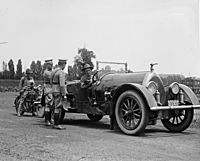
After the war, Butler became the commanding general of the Marine barracks at Marine Corps Base Quantico, Virginia. He turned the wartime training camp into a permanent Marine base. He made Quantico a "showplace" for the Marine Corps. He also led thousands of his men on long marches to Civil War battle sites like Gettysburg. There, they performed large-scale reenactments for crowds.
Philadelphia's Director of Public Safety
In 1924, the new Mayor of Philadelphia, W. Freeland Kendrick, asked President Calvin Coolidge to let a military general help fight crime and corruption in Philadelphia. Butler was chosen to be Philadelphia's director of public safety, in charge of the city's police and fire departments. He served from January 1924 to December 1925.
He started by telling all 4,000 police officers that things would change. He moved police units around the city to break up local crime rings. Within two days, he organized raids on over 900 illegal bars called speakeasies. He also tried to stop illegal gambling and police corruption. He even cracked down on popular places like the Ritz-Carlton.
Butler also improved city safety. He created new policies and a police uniform that looked like the Marine Corps uniform. He set up military-style checkpoints and used armored police cars. The public had mixed feelings. Some praised his efforts to reduce crime, but others felt he was too aggressive and took away their civil rights. Butler sometimes swore on the radio, which many found inappropriate for a high-ranking official.
His strong leadership style eventually caused problems with city officials. Mayor Kendrick even said he had the "guts to fire him." Butler prepared to return to the Marines. However, many citizens supported him and gathered to ask him to stay. The president allowed him to stay for another year.
In his second year, Butler focused on arresting criminals and enforcing Prohibition. On January 1, 1926, his leave ended, and the president did not extend it again. Butler resigned, saying later that "cleaning up Philadelphia was worse than any battle I was ever in."
Later Marine Service in China
From 1927 to 1929, Butler commanded a Marine force in Tientsin, China. He used his influence with different Chinese leaders to protect U.S. interests. When he returned to the United States in 1929, he was promoted to major general. At 48, he was the youngest major general in the Marine Corps.
In 1931, Butler caused a diplomatic issue by publicly sharing gossip about Benito Mussolini, the leader of Italy. The Italian government protested. President Herbert Hoover, who did not like Butler, ordered him to be court-martialed. Butler apologized, and the court-martial was canceled, but he received a reprimand.
Retirement and Activism
When the head of the Marine Corps, Maj. Gen. Wendell C. Neville, died in 1930, Butler was a candidate for the position. Many people supported him, but his outspokenness and past issues worked against him. The position went to Ben H. Fuller, who was less controversial. Butler asked to retire and left active duty on October 1, 1931.
Speaking Out Against War
After retiring, Butler became well-known for his speeches against war profiteering and U.S. military actions. He believed that wars were often fought for profit. He gave many lectures and donated much of his earnings to help people who were unemployed during the Great Depression.
In December 1933, he toured the country to recruit members for the Veterans of Foreign Wars (VFW). He told veterans to organize politically to get their benefits. He also criticized the government for its ties to big businesses.
From 1935 to 1937, he was a spokesperson for the American League Against War and Fascism. In 1935, he wrote his famous book, War Is a Racket. In it, he strongly criticized the idea that wars are fought for money.
The Business Plot Claims
In November 1934, Butler claimed that a group of powerful business leaders were planning to overthrow President Roosevelt. This became known as the Business Plot. Butler told a special committee of the House of Representatives that a man named Gerald P. MacGuire had asked him to lead a private army of 500,000 former soldiers to create a fascist government.
The people Butler named denied the plot, calling it a joke. However, the House committee's final report stated that "there was no question that these attempts were discussed, were planned, and might have been placed in execution." The committee confirmed many of Butler's statements. No one was prosecuted, and historians still debate how serious the plot was.
Later Life and Legacy
After retiring, Butler bought a home in Newtown Square, Pennsylvania. In June 1940, he became sick and went to the hospital. His doctor said he had an incurable illness, likely cancer. Smedley Butler died on June 21, 1940, at Naval Hospital, Philadelphia.
His funeral was held at his home. He was buried at Oaklands Cemetery in West Goshen Township, Pennsylvania. His family kept his home as it was, with many items he collected during his long career.
Honors and Awards
Butler received many awards for his service:
| 1st row | Medal of Honor | Medal of Honor 2nd award |
||||||||||
|---|---|---|---|---|---|---|---|---|---|---|---|---|
| 2nd row | Marine Corps Brevet Medal | Distinguished Service Medal (United States Navy) |
Distinguished Service Medal (United States Army) |
Marine Corps Expeditionary Medal with three bronze service stars |
||||||||
| 3rd row | Spanish Campaign Medal | China Relief Expedition Medal | Philippine Campaign Medal | Nicaraguan Campaign Medal | ||||||||
| 4th row | Haitian Campaign Medal | Dominican Campaign Medal | Mexican Service Medal | World War I Victory Medal with maltese cross |
||||||||
| 5th row | Yangtze Service Medal | National Order of Honour and Merit Grand Cross (Haiti) |
Haiti Médaille militaire | Commander of the Order of the Black Star (France) |
||||||||
Other Recognitions
- The USS Butler (DD-636), a destroyer, was named in his honor in 1942.
- The Boston, Massachusetts, chapter of Veterans for Peace is called the Smedley D. Butler Brigade.
- His childhood home in West Chester, The Butler House, is a registered landmark.
Promotions During His Career
| Rank | Promotion Date | Age | Location |
|---|---|---|---|
| Second lieutenant | June 10, 1898 | 16 | Washington, D.C. |
| First lieutenant | April 1899 | 17 | En route to Cavite, Philippines |
| Captain | July 23, 1900 | 18 | Tientsin, China |
| Major | October 1908 | 27 | Philadelphia, Pennsylvania |
| Lieutenant colonel | April 22, 1917 | 35 | Port-au-Prince, Haiti |
| Colonel | August 2, 1918 | 37 | Marine Corps Base Quantico, Virginia |
| Brigadier general | November 19, 1918 | 37 | Camp Pontanezen, Brest, France |
| Major general | July 13, 1929 | 47 | Marine Corps Base Quantico |
| Retirement | October 1, 1931 | 50 | Marine Corps Base Quantico |
Published Works
Books by Smedley Butler
- Butler, Smedley; Burks, Arthur J. (1927). Walter Garvin in Mexico. Philadelphia: Dorrance.
- Butler, Smedley (2003). War Is a Racket. Los Angeles: Feral House. ISBN 978-0-922915-86-6. https://archive.org/details/warisracket00smed_0.
Articles by Smedley Butler
- Smashing Crime and Vice (30-part newspaper series), Bell Syndicate, April–May 1926
- "American Marines in China," The Annals of the American Academy of Political and Social Science, July 1929
Images for kids
See also
 In Spanish: Smedley Butler para niños
In Spanish: Smedley Butler para niños
- List of Medal of Honor recipients
- List of Medal of Honor recipients (Veracruz)
- List of historically notable United States Marines


